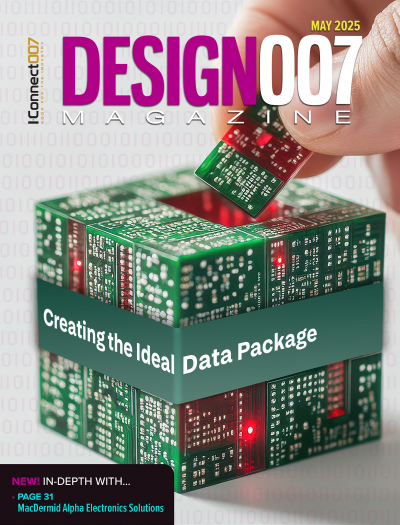-

- News
- Books
Featured Books
- design007 Magazine
Latest Issues
Current Issue
All About That Route
Most designers favor manual routing, but today's interactive autorouters may be changing designers' minds by allowing users more direct control. In this issue, our expert contributors discuss a variety of manual and autorouting strategies.

Creating the Ideal Data Package
Why is it so difficult to create the ideal data package? Many of these simple errors can be alleviated by paying attention to detail—and knowing what issues to look out for. So, this month, our experts weigh in on the best practices for creating the ideal design data package for your design.

Designing Through the Noise
Our experts discuss the constantly evolving world of RF design, including the many tradeoffs, material considerations, and design tips and techniques that designers and design engineers need to know to succeed in this high-frequency realm.
- Articles
- Columns
- Links
- Media kit
||| MENU - design007 Magazine
Cadence Paper: Automating Inter-Layer In-Design Checks in Rigid-Flex PCBs
May 25, 2016 | Ed Hickey, Cadence Design SystemsEstimated reading time: 10 minutes
Rigid-flex designs are unique when transferring the design data to the fabrication process. The various build-up of materials that make up the final product must be clearly defined. Identification of the various materials and correct order that define the layer structure must also be identified for each zone through proper documentation, or through intelligent manufacturing data formats (see Table 1). Failure to provide proper detailed information may result in costly delays or incorrect results of a final product. Communication with the fabricators to identify their requirements is key to a problem-free process.
Design houses and fabricators agree on a stack-up for a design that has impedance control or flex/rigid-flex designs because of the complexities involved. Traditionally, design houses and their fabrication partners use spreadsheets, presentations, and other such tools to communicate build intent. These methods are both time-consuming and error-prone. To avoid such problems and save time, advanced PCB designers now use IPC-2581 to exchange stack-up data electronically. IPC-2581 is an open, intelligent, neutral design data exchange format that is supported by over 85 PCB design and supply-chain companies worldwide. IPC-2581 revision B now supports bi-directional exchange of stack-up data to eliminate discovery of problems late in the design hand-off cycle.
Summary
Rigid-flex PCBs provide a reliable and flexible option for meeting the small form factor and low weight requirements of a variety of applications. However, as flexible technology has evolved, new design challenges have cropped up. PCB design technology that automates the detection of errors as they are made through in-design inter-layer checks in rigid-flex PCBs can help meet these challenges, helping you deliver a quality product within the desirable time-to-market window.
Ed Hickey is product engineering director of Cadence Design Systems.
About Cadence Design Systems
Cadence Design Systems enables global electronic design innovation and plays an essential role in the creation of today’s electronics. Customers use Cadence software, hardware, IP, and expertise to design and verify today’s mobile, cloud and connectivity applications. Visit www.cadence.com.
SPONSORED LINKS
Allegro Flex and Rigid-Flex Technologies
Electrical Design Challenges for Automotive PCBs
Allegro Rigid-Flex Demo Available, Click Here
Page 4 of 4
Suggested Items
Driving Innovation: Direct Imaging vs. Conventional Exposure
07/01/2025 | Simon Khesin -- Column: Driving InnovationMy first camera used Kodak film. I even experimented with developing photos in the bathroom, though I usually dropped the film off at a Kodak center and received the prints two weeks later, only to discover that some images were out of focus or poorly framed. Today, every smartphone contains a high-quality camera capable of producing stunning images instantly.
Hands-On Demos Now Available for Apollo Seiko’s EF and AF Selective Soldering Lines
06/30/2025 | Apollo SeikoApollo Seiko, a leading innovator in soldering technology, is excited to spotlight its expanded lineup of EF and AF Series Selective Soldering Systems, now available for live demonstrations in its newly dedicated demo room.
Indium Corporation Expert to Present on Automotive and Industrial Solder Bonding Solutions at Global Electronics Association Workshop
06/26/2025 | IndiumIndium Corporation Principal Engineer, Advanced Materials, Andy Mackie, Ph.D., MSc, will deliver a technical presentation on innovative solder bonding solutions for automotive and industrial applications at the Global Electronics A
Fresh PCB Concepts: Assembly Challenges with Micro Components and Standard Solder Mask Practices
06/26/2025 | Team NCAB -- Column: Fresh PCB ConceptsMicro components have redefined what is possible in PCB design. With package sizes like 01005 and 0201 becoming more common in high-density layouts, designers are now expected to pack more performance into smaller spaces than ever before. While these advancements support miniaturization and functionality, they introduce new assembly challenges, particularly with traditional solder mask and legend application processes.
Knocking Down the Bone Pile: Tin Whisker Mitigation in Aerospace Applications, Part 3
06/25/2025 | Nash Bell -- Column: Knocking Down the Bone PileTin whiskers are slender, hair-like metallic growths that can develop on the surface of tin-plated electronic components. Typically measuring a few micrometers in diameter and growing several millimeters in length, they form through an electrochemical process influenced by environmental factors such as temperature variations, mechanical or compressive stress, and the aging of solder alloys.


